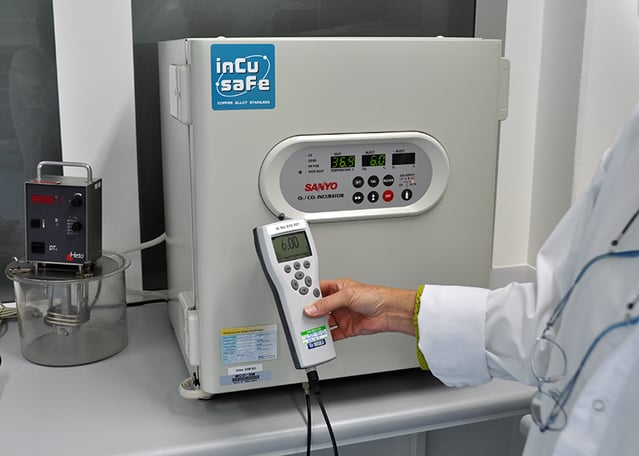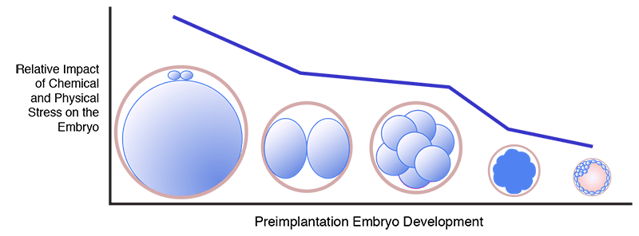 Temperature, pH and osmolality are some of the most important parameters to take into account during In Vitro embryo culture. In any good quality management system these parameters, amongst others, should be monitored and regulated on a regular basis to ensure optimal culture conditions are maintained. In this blog post I will specifically highlight the importance of pH and its relation to CO2 measurements for successful results in IVF.
Temperature, pH and osmolality are some of the most important parameters to take into account during In Vitro embryo culture. In any good quality management system these parameters, amongst others, should be monitored and regulated on a regular basis to ensure optimal culture conditions are maintained. In this blog post I will specifically highlight the importance of pH and its relation to CO2 measurements for successful results in IVF.
What is pH?
pH is a figure expressing the acidity or alkalinity of a solution on a logarithmic scale on which 7 is neutral, lower values are more acid and higher values more alkaline. pH is the negative of the logarithm to the base 10 of the activity of the hydrogen ion (-log [H+]). H+ ions are needed for metabolic pathways and the effect of a pH-difference of 1 unit implies a 10-fold increase/decrease of [H+]. Therefore the pH-difference of 0.2 units from 7.4 to 7.2 ,which is the acceptable range with which we work in the IVF lab, is actually a 60% change in [H+] 1.
The relationship between pH and CO2
The bicarbonate buffering system is mostly used in culture media as a means to buffer the acid-base equilibrium. In this system, carbon dioxide (CO2) combines with water (H2O) to form carbonic acid (H2CO3), which in turn rapidly dissociates to form hydrogen ions (H+) and bicarbonate (HCO3−) as shown in the following reactions:
CO2 + H2O <=> H2CO3 <=> H+ + HCO3-
By increasing the CO2 concentration, the equation shifts towards the right, releasing more H+ ions and the medium becomes more acidic, resulting in a lower pH.
The effect of pH on the embryo
Many of the intracellular processes that take place in the embryo are regulated by pH. In mice, the raising (about pH 7.4) and lowering (about pH 6.8) of pH for only 3 hours disrupts localisation of mitochondrial and actin filaments compared with controls (pH 7.2)2. The regulation of various enzymes, embryo glycolysis and oxidative metabolism are a few other intracellular processes that can have an impact on the developmental competence of an embryo1.
Embryos show stage-specific sensitivity to stress
Intracellular pH is much more difficult to control by the oocyte than by the later stage embryos and it is during the oocyte and early stages of embryo development that sub optimal handling in the lab have the most significant impact. This is a reason why embryos show a stage-specific sensitivity to stress3. There are certain intracellular mechanisms in place enabling the human embryo to regulate its internal pH but it is still the responsibility of the embryologist to minimise fluctuations of pH during embryo culture.

Illustration from Wale and Gardner 20153.
A correct measurment of pH can be complicated
Measuring pH is a very accurate way of monitoring the conditions of the culture environment. However, pH measurements are very easy to get wrong due to the complexity of the measuring process and the amount of variables that will influence the outcome. Most pH measuring devices are designed to measure larger volumes and not micro droplets of media that are often used in the IVF labs.
Very few laboratories have access to equipment that can perform accurate measurements in a controlled environment. Blood gas analysers are often used in larger hospitals where this type of equipment is used for patients. IVF labs associated with such hospitals and in close proximity of the blood gas analyser may use this as a method to very accurately measure the pH of the culture media. There is usually a distance to cover with the sample from the laboratory to the analyser and therefore important to make sure that samples are tightly capped to avoid any gas phase exchange. More recently portable blood gas analysers have become more readily available on the market, but considering the cost of the device and consumables this is not the obvious choice for many labs.
A correct measurment of CO2 is much easier
Measuring the concentration of CO2 on the other hand is less complicated and has much less variables that can affect the final reading. Your media manufacturer should provide a certificate of analysis for each product, indicating the pH that will be achieved in the media at a specified setting of CO2 at sea level. Digital electronic CO2 analysers are the preferred device when it comes to measuring CO2 and far more accurate than a liquid-based system such as Fyrite. CO2 analysers should be calibrated regularly with a traceable standard and known sample gas to assure its accuracy.
Culture media to fit your everyday routines
When it comes to embryo culture, there are several different media types to choose from but the preferred choice would be to maintain the pH of the culture media at a level that reflects physiological pH as close as possible. The pH of every batch of Vitrolife culture media is meticulously measured and validated during the production process with a tried and tested method. Due to the relationship between CO2 concentration and pH, we can then recommend the correct concentration of CO2 to be used inside the incubator to maintain the correct pH for that media type at sea level. If a lab is situated in a location significantly higher than that of sea level, the altitude will affect the partial pressure of the CO2 in the medium. Be sure to accurately measure the pH first and then adjust the CO2 output of the culture incubator accordingly3.
Follow recommendations from manufacturers
It is common practice that a lab may change the type of culture media they use at some time or another. It is very important that the CO2 concentration recommended by the media manufacturer is used when changing from one commercial media to another. If the pH is already at the edge of the physiological range due to an incorrect CO2 setting of the incubator, something as simple as incubator door openings will cause a prolonged exposure of the embryos to a sub-optimal culture environment with detrimental effects on the eventual outcome.
Minimise exposure to sub optimal CO2 levels
Be meticulous in the way you work and handle the embryos to minimise exposure of the embryos and culture dishes to sub optimal CO2 concentrations. The use of IVF chambers or isolettes is one way of minimising the changes in CO2 concentrations when embryos have to be handled outside of the incubator. Most commonly, a good handling media containing either a MOPS or HEPES buffer, is used during the handling steps of oocytes and embryos outside of the incubator such as oocyte collection, denudation, ICSI, assisted hatching and biopsy.
Time-lapse culture can reduce pH fluctuations
It is very important to minimise the number of incubator door openings on a daily basis. Too often labs do not have enough incubators for the number of patients they are treating. As a clinic grows and cycle numbers increase, pay attention to the ratio of cases per incubator. The proper use of time-lapse culture systems in recent years is one way of circumventing the problem of door openings and the associated problems regarding fluctuations in pH in the culture dishes.
References
Topics: Embryo culture & transfer
Written by Jaco Terblanche
When there is a problem in a clinic needed to be solved, Jaco is never far away. This former Lab Manager now spends his working time travelling around the globe to support IVF clinics to improve their results.